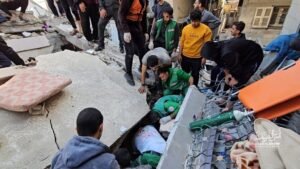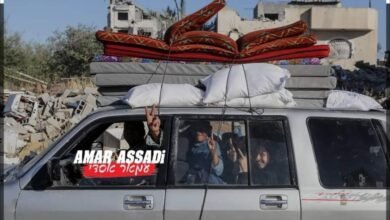
| The claim |
| Matthew Miller, spokesperson for the US State Department: no evidence that the Israeli government targets civilians. We have no information about the targeting of Palestinian journalists by Israel during this war. |
Matthew Miller, spokesperson for the US State Department, stated in a press conference yesterday, Monday, that Washington has found no evidence that the Israeli government targets civilians. He also mentioned the absence of information regarding the targeting of Palestinian journalists by Israel during this war.
واشنطن تقول إنها لا ترى دليلا على تعمد إسرائيل قتل المدنيين
archived 6 Dec 2023 11:55:29 UTC
The Palestinian Observatory “Tahaqaq” investigated the validity of the American claims by examining public sources and communicating with live sources. Tahaqaq concluded that the US State Department’s statements about the lack of evidence regarding Israeli targeting of Palestinian civilians and journalists are misleading, based on the following evidence:
First: Targeting Palestinian Hospitals in Gaza:
Israeli occupation forces targeted several hospitals in the Gaza Strip, which housed thousands of displaced civilians, wounded, and martyrs, the majority of whom were civilians. Through research into public sources, media organizations and journalists documented several massacres and attacks, including:
1- The Al-Mashtal Hospital Massacre:
Last October 17th, Israeli occupation aircraft targeted the Al-Mashtal Private Hospital, which housed thousands of civilian refugees. The attack resulted in the deaths of more than 500 Palestinians, mostly women and children. The observatory documented the responsibility of the occupation for the massacre, despite attempts to disclaim it through the release of old videos and a misleading narrative about what happened in the hospital. Tahaqaq confirmed this through a comparison of Al Jazeera’s live coverage with another video angle, proving that the bombing was missile-based from the air and not a failed launch by The elements of the armed Palestinian factions. Another report by the “ECAD” platform also confirmed the responsibility of the occupation for the massacre and the inaccuracy of the Israeli military spokesperson’s account of the launch source.
Video documenting the moment of Al-Mashtal Hospital bombing by the occupation aired live on Al Jazeera, estimating the time of the bombing at 6:59
Another video, compared with Al Jazeera’s coverage of the bombing at that time, alongside a video captured by a citizen from his home balcony, showing the missile hitting the hospital.
Israeli journalist Ehud Keinan’s announcement during a TV interview with Channel 12 about the Israeli army’s bombing of Al-Mashtal Hospital before the interview was deleted by the channel.
Details of the Al-Mashtal Hospital massacre narrated by Dr. Fadel Naim, one of the hospital’s doctors.
Image of victims of the Al-Mashtal Hospital, who lost their lives due to the missile bombardment of the hospital, taken by journalist Abdul Khaled, a photographer for the Associated Press.

2- Hospital Wars:
On November 4th, Israeli occupation aircraft bombed the entrance of Al-Nasser Children’s Hospital in western Gaza, targeting displaced individuals seeking refuge, resulting in the death and injury of several people.
Shocking scenes emerged from inside the hospital on November 29th, revealing decomposed bodies of children left in Al-Nasser Children’s Hospital after Israeli forces forced its staff and patients to evacuate.
Following the targeting of Al-Mashtal Hospital, the Israeli occupation army besieged the Al-Shefa Medical Complex for about a week, repeatedly shelling the hospital surroundings. It eventually stormed the complex on November 15th, targeting the hospital’s main gate on November 4th, leading to the death of more than 15 civilians and dozens of injuries. Al Jazeera correspondent Wael Al-Dahdouh confirmed this from inside the hospital, where the spokesperson for the Gaza Ministry of Health, Dr. Ashraf Al-Qudra, confirmed the death of seven premature babies, in addition to other casualties. The occupation forces also detonated a warehouse of medical tools and equipment, destroying modern medical devices like the MRI, rendering the complex entirely out of service.
Israeli forces invaded the Indonesian Hospital in northern Gaza on November 24th after the hospital had been subjected to several violent attacks just before the implementation of the humanitarian ceasefire, according to Ministry of Health spokesperson Dr. Ashraf al-Qudra, resulting in the death of 12 Palestinians in one of the bombings on November 20th.
Additionally, the Israeli occupation targeted Kamal Adwan Hospital in Jabalia, northern Gaza, leading to the death of four Palestinian citizens and at least nine injuries, including children and women, due to the targeting of the hospital’s northern gate by a missile launched by an Israeli reconnaissance plane.
According to the latest update from the Palestinian Ministry of Health regarding the civilian casualties in Gaza and the health situation in hospitals from October 7th to December 4th, more than 15,000 people were martyred, and around 40,000 were injured, including 6,000 children and 4,000 women. The report indicates that 20 hospitals are still out of service, despite some resuming operations. Additionally, 55 ambulances are out of service, and more than 250 health workers were martyred, with approximately 30 health workers unlawfully detained.
68g9LRUKdXanesNp8C3c8LzJ_ivxxDBuTRcTjfwLUuL8BZPp3
Second: Targeting Shelter Centers, Schools, and UNRWA Facilities
Israeli occupation aircraft targeted numerous schools housing thousands of displaced civilians, acting as shelters. For example, on November 2nd, the “Abu Assi” school in the Shati refugee camp was bombed with white phosphorus bombs, as confirmed by activist Ahmed Hijazi in a previous report. He mentioned that the school was subjected to three types of attacks simultaneously: phosphorus bombs, artillery shells, and smoke bombs.
Media reports, including Al Jazeera correspondent Wael Al-Dahdouh, documented direct airstrikes by Israeli warplanes on a shelter school in Ma’an area, east of Khan Yunis, on Tuesday afternoon, resulting in the martyrdom of several individuals in addition to numerous injuries.
Third: Targeting Displaced Individuals in Safe Crossings and Shelter Areas.
Since the start of the war in Gaza after the events of October 7th, the Israeli occupation army instructed residents of northern Gaza to leave their homes and move to areas south of Wadi Gaza through safe passages, allowing civilians to move without any targeting. However, the Israeli occupation targeted a large number of displaced individuals by bombing the vehicles transporting them on Salah al-Din Street with planes and artillery or targeting pedestrians on the same road by occupation soldiers. One of the victims was the elderly Palestinian Bashir Haji (79 years old) from the Zaytoun neighborhood, who was field-executed while crossing the “safe passage” on Salah al-Din Street. This was documented by the Euro-Mediterranean Observatory for Human Rights, which confirmed his field execution on the morning of Friday, November 10th, by firing several gunshots into his head and back, brutally executing him as he crossed the evacuation route, contrary to what the Israeli army claimed in its propaganda about assisting its soldiers in helping the elderly man cross the passage.

Fourth: Targeting Palestinian Citizens’ Homes in Gaza Without Prior Notice
During the war in Gaza, the Israeli warplanes notably targeted residential areas, neighborhoods, and homes of Palestinians. This was vividly demonstrated in videos released by the occupying forces, showing the bombardment of residential areas under the pretext of assassinating a leader of the Hamas movement. One such incident was the second Jabalia massacre on December 2nd, resulting in the martyrdom of over 100 individuals in the Israeli airstrikes targeting a house sheltering families and displaced people in Jabalia camp in the northern Gaza Strip, as confirmed by Al Jazeera correspondent.
The aftermath of Israeli airstrikes on the Obeid family’s house, accommodating families and displaced individuals in Jabalia camp, led to the martyrdom and injury of dozens, along with ongoing search operations for missing persons, captured by journalist Anas Al-Sharif.
A video published by the Israeli army shows the moment it targeted one of the residential squares:
According to Dr. Ashraf Al-Qudra, the spokesperson for the Gaza Ministry of Health, the massacres resulted in the martyrdom of approximately 193 and injuries to 652 individuals.
Journalist Anas Al-Sharif for Al Jazeera documented the extensive destruction inflicted on Jabalia Market, one of the oldest and largest markets in Gaza, following the Israeli airstrikes on Monday. The commercial shops and stalls have been reduced to rubble.
The aftermath of the Israeli airstrikes on the Mua’sksr Market in Jabalia, leading to the complete destruction of the market, captured by journalist Hussam Shabat.
Journalist Qasim Al-Aga confirmed to us that the occupation targeted most civilian homes in Gaza without prior warning. The occupation forces targeted his home, his sister’s home, and his family’s home located behind Al-Quds Hospital in the Tel Al-Hawa area of Gaza City from the early days of the war.
Al-Aga explained, “By the grace of God, our family had evacuated the homes earlier because there was random shelling at that time without any prior notification to the homeowners.”
He pointed out that they confirmed with the owners of neighboring houses if they had been informed of the impending bombing of their homes. However, they affirmed that no notifications were received by any home, emphasizing that when notifications do occur, all residents of the area are usually informed (which is extremely rare).
Al-Aga stated that another indication of the lack of prior warning is the presence of injuries among residents of neighboring homes following the airstrikes that targeted their house.
Moment of Israeli forces targeting residential buildings in the “Hammad Housing” area in Khan Yunis city, central Gaza Strip, on December 2, 2023.
Fifth: Israeli Occupation Flagrantly Targeted Journalists and Media Institutions in Gaza During its Campaign.
Journalist Omar Nazal, a member of the Journalists’ Syndicate, affirmed to us that the statement from the U.S. State Department is evidence that they are complicit in the assassination of journalists, fully adopting the Israeli narrative.
Nazal pointed out that on the sixtieth day of the war, the Syndicate documented no less than 390 crimes and serious violations against journalists and media outlets in the West Bank and Gaza. This includes the martyrdom of 75 journalists and media workers, two missing individuals, and approximately 80 journalists injured. Moreover, 60 journalists’ homes were bombed, 59 media institutions and offices were destroyed, and the work of 25 radio stations, including 24 in Gaza and one in the occupied West Bank, was disrupted. Three media outlets were closed or restricted, and 43 journalists were arrested, including 41 in the West Bank and two in Gaza, with 30 still under arrest, most of whom were transferred to administrative detention.
Journalist Amr Tabsh, who refuted the U.S. State Department’s statements, stated, “Journalists are always in the crosshairs of the Israeli occupation. Despite always wearing full journalist attire, we are directly targeted. I witnessed that the occupation fires randomly, assassinating more than 60 journalists, in addition to the families of many journalists.”
He added, “I was injured in my legs and back when a wall of a house I went to cover after it was targeted in the north of the Strip collapsed.”
Therefore, the Palestinian Observatory “Tahaqaq” based on documented evidence, citizen testimonies, and information from journalists who were accessible to the Observatory, asserts that the U.S. State Department’s statements are misleading. The State Department did not provide any evidence to prove that the occupation did not target civilians or journalists.
| Prosecution sources |
| Statement by US State Department spokesman Matthew Miller. |
















